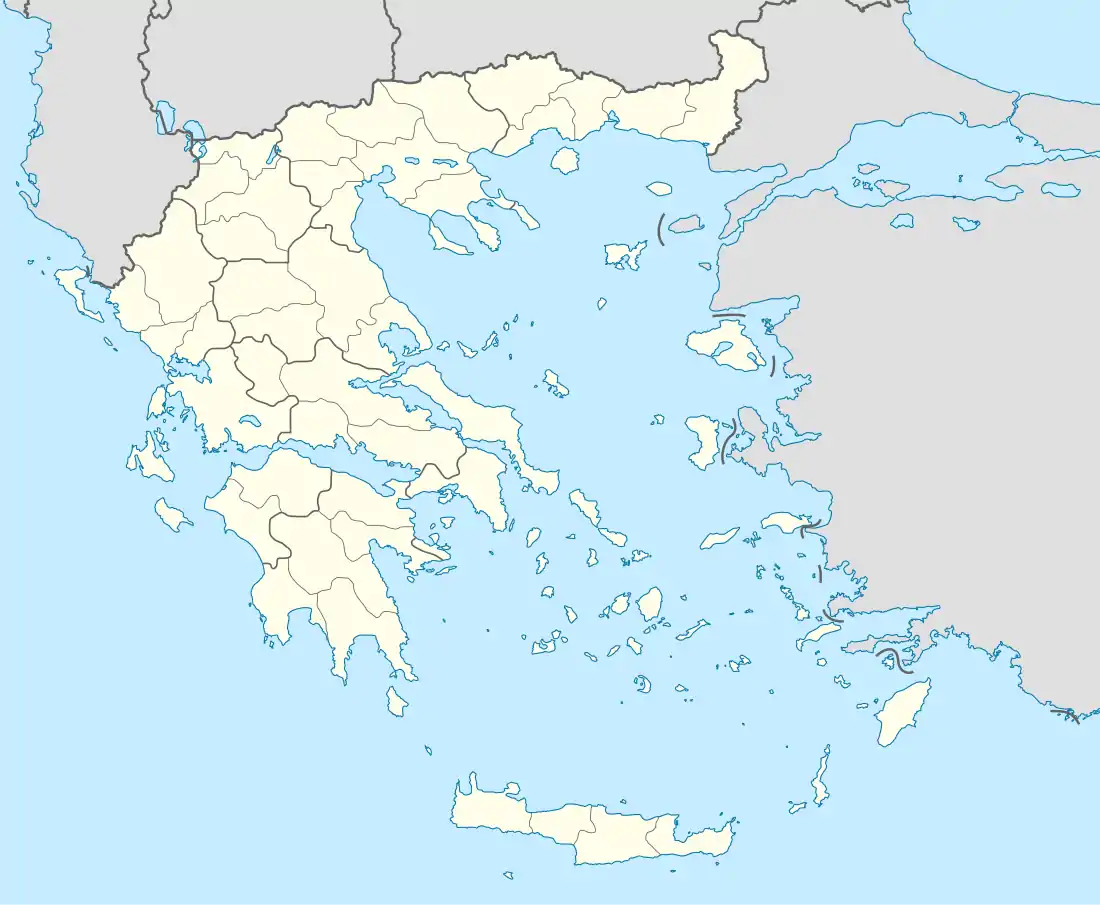Azoros
Azoros (Greek: Άζωρος, Greek pronunciation: ['azoɾos]) is a village and a community of the Elassona municipality in the Larissa regional unit.[2] Before the 2011 local government reform it was a part of the municipality of Sarantaporo, of which it was a municipal district.[2] The 2011 census recorded 333 inhabitants in the village.[1] The community of Azoros covers an area of 20.308 km2.[3]
Azoros
Άζωρος | |
|---|---|
 Azoros | |
| Coordinates: 40°0′N 22°4.7′E | |
| Country | Greece |
| Administrative region | Thessaly |
| Regional unit | Larissa |
| Municipality | Elassona |
| Municipal unit | Sarantaporo |
| Elevation | 520 m (1,710 ft) |
| Community | |
| • Population | 333 (2011) |
| • Area (km2) | 20.308 |
| Time zone | UTC+2 (EET) |
| • Summer (DST) | UTC+3 (EEST) |
| Postal code | 402 00 |
| Area code(s) | +30-2493-xxx-xxx |
| Vehicle registration | PIx-xxxx |
Geography
Azoros is built at an altitude of 520 meters[4] at the foot of Mount Amarbeis, at a distance of 18 kilometers from Elassona, near the ruins of the ancient thessalian city of Azorus.
Near the city flows the river Titarisios, an important tributary of the Pineios. There are also natural springs in the nearby areas of Tsouknida, Tsimpitoura and Tsimpitoroula (Greek: Τσουκνίδα, Τσιμπιτούρα, Τσιμπιτορούλα).[5]
Mount Olympus, the highest mountain in Greece, is situated about 25km Northeast of Azoros.
History
The ancient citadel of Azoros[6] and the walls of the Hellenistic and mid-Byzantine period are situated Southeast of the town, on the hill named "Kastri".[7]
The area was controlled by the Byzantine Empire, until 1420 when Turahan Bey, an Ottoman military Commander, conquered the mountainous Perrhaebia.[8]
Until 1991 the town was called Vouvala or Vuvala (Βουβάλα), but was renamed to reflect the ancient city of Azorus which is located within the community. The town was liberated by the Greek Army during the Balkan Wars and was extensively destroyed during the Axis occupation of Greece and the Greek Civil War.
Economy
The population of Azoros is occupied in animal husbandry and agriculture.[8]
Population
According to the 2011 census, the population of the settlement of Azoros was 333 people, a decrease of almost 33% compared with the population of the previous census of 2001.[1][3]
| Year | 1928 | 1940 | 1951 | 1961 | 1971 | 1981 | 1991 | 2001 | 2011 |
|---|---|---|---|---|---|---|---|---|---|
| Population | 484 | 619 | 681 | 739 | 608 | 529 | 724 | 551 | 333 |
Culture
The main events of the village take place on January 7 (procession from the Olympiotissa monastery), July 26 (Feast of St. Paraskevi) and Clean Monday with the custom of representing a traditional wedding attract visitors to the area.[8]
References
- "Απογραφή Πληθυσμού - Κατοικιών 2011. ΜΟΝΙΜΟΣ Πληθυσμός" (in Greek). Hellenic Statistical Authority.
- Kallikratis law Government’s Gazette (in Greek)
- "Population & housing census 2001 (incl. area and average elevation)" (PDF) (in Greek). National Statistical Service of Greece. Archived from the original (PDF) on 2015-09-21.
- Μιχαήλ Σταματελάτος - Φωτεινή Βαμβά Σταματελάτου, Γεωγραφικό Λεξικό της Ελλάδας, ΤΑ ΝΕΑ, 2012, Α' τόμος, σ. 46.
- "Ιστορία Αζώρου - Elassona-City.gr - Η #1 ηλεκτρονική εφημερίδα της επαρχίας Ελάσσονας". Elassona-city.gr (in Greek). Retrieved 2020-12-23.
- "2000-2010 ΑΠΟ ΤΟ ΑΝΑΣΚΑΦΙΚΟ ΕΡΓΟ ΤΩΝ ΕΦΟΡΕΙΩΝ ΑΡΧΑΙΟΤΗΤΩΝ" (PDF). Athens: ΥΠΟΥΡΓΕΙΟ ΠΟΛΙΤΙΣΜΟΥ ΚΑΙ ΤΟΥΡΙΣΜΟΥ (MINISTRY OF CULTURE AND TOURISM) ΓΕΝΙΚΗ ΔΙΕΥΘΥΝΣΗ ΑΡΧΑΙΟΤΗΤΩΝ ΚΑΙ ΠΟΛΙΤΙΣΤΙΚΗΣ ΚΛΗΡΟΝΟΜΙΑΣ. 2012.
- "Ακρόπολη Αζώρου".
- "Άζωρος (Βουβάλα)". elassona.com.gr. Retrieved 7 December 2014.